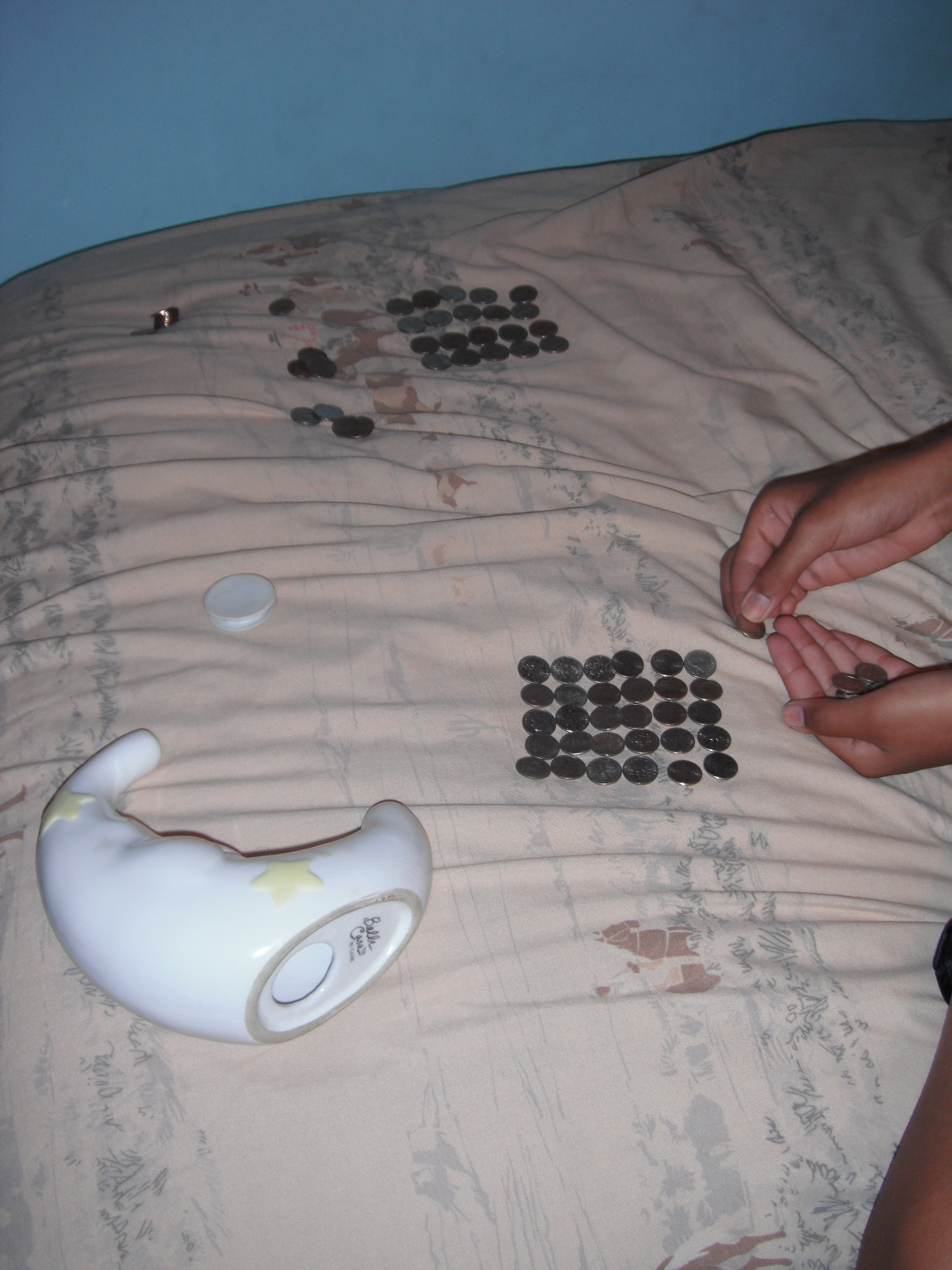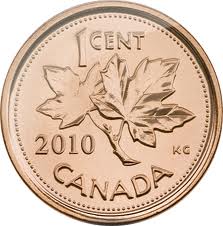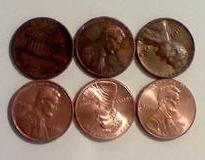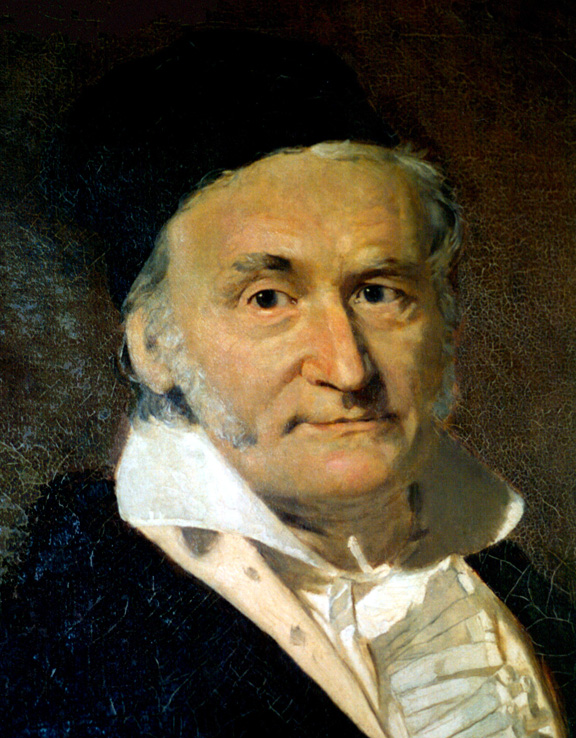- Reminder: turn off your rectangles!
- Your first assignment is returned.
Your score is out of 2. One point for Pascal's Triangle, and one point for Yanghui's next line, using bamboo counting rods.
I did ask you to "Include an explanation of how you chose to represent any numbers that haven't already appeared in the table."
You have to justify your work. I want to know how you were thinking when you made your choices. Otherwise, for all I know, you just put down counting rods randomly....
- You have a new assignment, due next Thursday. Remember: justify your work!
We talked about some possible strategies:
- Tallies
(you assigned reading for today talked more about tallies).
- One-to-one correspondence
- using body parts -- "one hand" of sheep, say -- meaning five sheep.
- cairns
- And then an unusual method of "counting by partitions" that
Patricia Baggett and Andrzej Ehrenfeucht proposed at the 2011
National Math Meetings.
- They proposed that primitive societies may have counted
this way. Let's suppose you need to let the King know how many
sheep you have:
- divide your sheep equally ("one for you, one for me") into two pens: either there is one left over, or not. You make a note of whether there is one left over or not.
- Send all the sheep in pen two (and any "left over") out to pasture, and then
- You divide the sheep in pen one into pens one and two: i.e., just do it again! And again, and again, and.... until you get down to a pen one with just sheep in it.
- Now let's see how we might record the results to send to
the King.
The easiest way to illustrate the counting method is via a tree.
Let's see how we might use a tree to represent the solution to the "22" counting problem: in the linked example, we would get 10110 by writing the remainders from left-to-right starting from the bottom of the tree. (The result should always start with a 1 if done correctly, since we always end with one sheep!)

The answer will be written as 1, 0, 1, 1, 0
That is, from the bottom up, left to right. This is important! We have to have a consistent scheme for writing.
So how do we write
- 9 sheep
- 31 sheep
- 54 sheep
- Can you go backwards? How many sheep is meant by
- 1,1,0,1,1,0,0
- 1,1,0,1,1,0,0
- 1,0,0,1,0,1,1,0,1
Try making a tree with these remainders.
- They proposed that primitive societies may have counted
this way. Let's suppose you need to let the King know how many
sheep you have:
Each of these number concepts can easily be understood using pennies:
- prime,
- composite,
- square, and
- triangular numbers
So we're interested in arranging our pennies (i.e. rocks) in groups with certain properties.

I caught my son using these ideas to put some of his change into rolls to cash in. Those are dimes he's working with. Question for you detectives out there: what did he do next?
All numbers of pennies can be arranged into a line (this is Humphrey's "Furry Arms" method):





Some numbers of pennies (composites) can be arranged into
- rectangles (of more than one row):

Note that this is how Humphrey said the number of fish -- he blocked the fish into two groups of three fish --
fish fish fish,
fish fish fish - squares
- triangles
Another way of saying that a number is composite is to say that it can be broken up into groups (each with more than one member) that can each be put into one-to-one correspondence with each other (that is, each element in one group has a partner in another -- and just one partner. Perfect for the dance....).
So 9 is an example, a square. It can be broken into three groups of three; so each group of three can be put into one-to-one correspondence with any other group of three.
Notice that we said greater than one in the definition above. The number 1 is special, and considered neither prime nor composite.
We've already heard this important rule, which you learned at some point in your mathematical education:
- odd and even
- odd and odd
- even and even
| + | Odd | Even |
| Odd | ||
| Even |
Rock groups suggest formulas for representing even and odd numbers:
| Evens: | 2*n |
| Odds: | 2*n+1 |
How would you say what's happening in words? What do you think of the proof of the "theorem" at the bottom of the page?
- Do you see the theorem expressed in the rocks?
- Can you see the form "2n+1" in the rocks?
- I see a new theorem: T5+T4=52 (In words, "the sum of the fourth and fifth triangular numbers is the fifth square".) By playing with rocks we discover relationships. It's probably how primitive civilizations did it, too!

Once again, rock groups give us a formula for representing triangular numbers. So let's go through the reasoning for the housekeeper's answer.
What can we deduce about
- the Babylonians and place value?
- the purpose of the table?
- the Babylonian's missing number(s)?
How would the Babylonians write these numbers:
- 3600
- 573
- 14001
- How cumbersome are the Roman numerals! How would you write your own birth year?
- "biology is deeply embedded" in number systems (10 "digits" in our system; tallies of 5; 5 and 10 in Roman numerals; 10 in Babylonian; 5 and 20 for the Mayans)
- Babylonians based their system on
-- its prime factorization gives it lots of factors.
- We need no new symbol for 10 in our arabic numerals: we use only the digits 0, 1, 2, 3, 4, 5, 6, 7, 8, 9 -- and place value (hence the name of the chapter: "location, location, location").
- Place value suddenly makes arithmetic possible. "Just
master a few facts", our author says.
My own musing: it's interesting that we seem to be abdicating our arithmetic to machines. Many educated people can't do arithmetic anymore....
- The unsung hero is the digit 0 -- a symbol for nothing! (The Babylonians can't distinguish the numbers 1 from 60, without some additional context.)
- Binary, or base 2 math: a place-value system with just two symbols, 0 and 1. Perfect for computers....
- Cornell built the first telegraph line (Baltimore to Washington, D.C.): 1844. I know that the telegraph displaced the pony express, which only ran for one year, at the beginning of the Civil War (1860-1861).